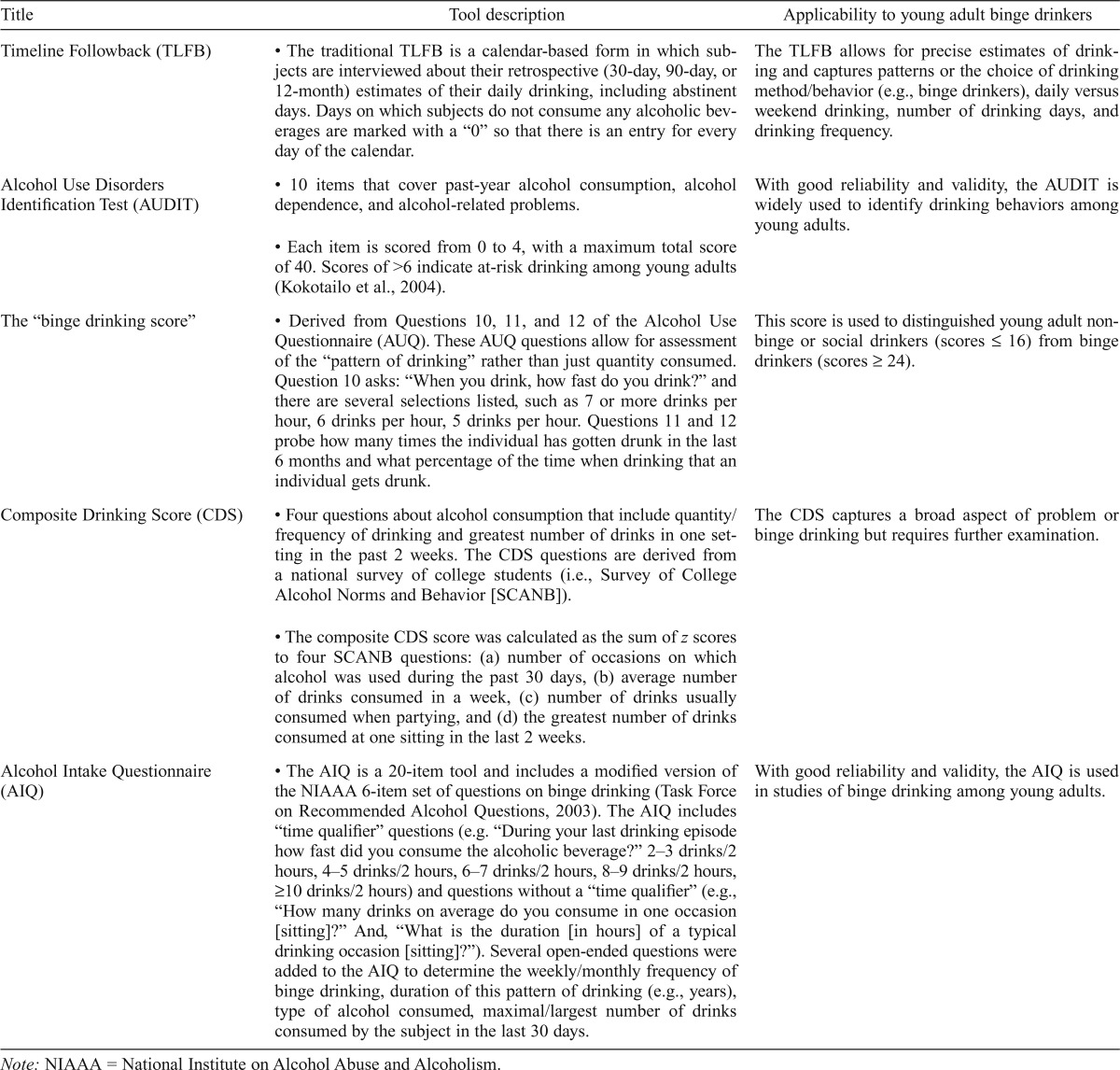Table 2.
Alcohol questionnaires and tools
| Title | Tool description | Applicability to young adult binge drinkers |
| Timeline Followback (TLFB) | • The traditional TLFB is a calendar-based form in which subjects are interviewed about their retrospective (30-day, 90-day, or 12-month) estimates of their daily drinking, including abstinent days. Days on which subjects do not consume any alcoholic beverages are marked with a “0” so that there is an entry for every day of the calendar. | The TLFB allows for precise estimates of drinking and captures patterns or the choice of drinking method/behavior (e.g., binge drinkers), daily versus weekend drinking, number of drinking days, and drinking frequency. |
| Alcohol Use Disorders Identification Test (AUDIT) | • 10 items that cover past-year alcohol consumption, alcohol dependence, and alcohol-related problems. | With good reliability and validity, the AUDIT is widely used to identify drinking behaviors among young adults. |
| • Each item is scored from 0 to 4, with a maximum total score of 40. Scores of >6 indicate at-risk drinking among young adults (Kokotailo et al., 2004). | ||
| The “binge drinking score” | • Derived from Questions 10, 11, and 12 of the Alcohol Use Questionnaire (AUQ). These AUQ questions allow for assessment of the “pattern of drinking” rather than just quantity consumed. Question 10 asks: “When you drink, how fast do you drink?” and there are several selections listed, such as 7 or more drinks per hour, 6 drinks per hour, 5 drinks per hour. Questions 11 and 12 probe how many times the individual has gotten drunk in the last 6 months and what percentage of the time when drinking that an individual gets drunk. | This score is used to distinguished young adult nonbinge or social drinkers (scores ≤ 16) from binge drinkers (scores ≥ 24). |
| Composite Drinking Score (CDS) | • Four questions about alcohol consumption that include quantity/ frequency of drinking and greatest number of drinks in one setting in the past 2 weeks. The CDS questions are derived from a national survey of college students (i.e., Survey of College Alcohol Norms and Behavior [SCANB]). | The CDS captures a broad aspect of problem or binge drinking but requires further examination. |
| • The composite CDS score was calculated as the sum of z scores to four SCANB questions: (a) number of occasions on which alcohol was used during the past 30 days, (b) average number of drinks consumed in a week, (c) number of drinks usually consumed when partying, and (d) the greatest number of drinks consumed at one sitting in the last 2 weeks. | ||
| Alcohol Intake Questionnaire (AIQ) | • The AIQ is a 20-item tool and includes a modified version of the NIAAA 6-item set of questions on binge drinking (Task Force on Recommended Alcohol Questions, 2003). The AIQ includes “time qualifier” questions (e.g. “During your last drinking episode how fast did you consume the alcoholic beverage?” 2–3 drinks/2 hours, 4–5 drinks/2 hours, 6–7 drinks/2 hours, 8–9 drinks/2 hours, ≥10 drinks/2 hours) and questions without a “time qualifier” (e.g., “How many drinks on average do you consume in one occasion [sitting]?” And, “What is the duration [in hours] of a typical drinking occasion [sitting]?”). Several open-ended questions were added to the AIQ to determine the weekly/monthly frequency of binge drinking, duration of this pattern of drinking (e.g., years), type of alcohol consumed, maximal/largest number of drinks consumed by the subject in the last 30 days. | With good reliability and validity, the AIQ is used in studies of binge drinking among young adults. |
Note: NIAAA = National Institute on Alcohol Abuse and Alcoholism.

